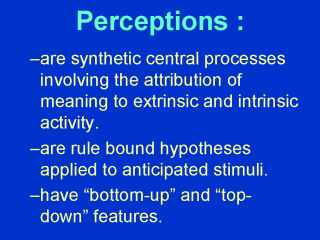| front |1 |2 |3 |4 |5 |6 |7 |8 |9 |10 |11 |12 |13 |14 |15 |16 |review |
 |
While
sensation is a result of peripheral sensory activity, perception is a central process
which synthesizes “experience” by attributing meaning to patterns of activity which
may be peripherally or centrally generated. Not all afferent sensory activity gets
processed beyond a basic, pre-conscious level, and much is never “perceived”. One feature that seems well-established is that perceptual systems work on the basis of rule-application. In other words, there seems to be an hypothesis-testing process involved which attempts to find a “best-fit” interpretation for a particular pattern of cortical activity, whether it has a peripheral or central origin. This is particularly apparent when we look at language processing. The range of possible words that a speaker may produce is much greater than the CNS can deal with if it were to process each word as a separate randomly occuring entity. Instead, what seems to happen is that that context (topic of conversation) and rules of grammar help limit the number of choices the system has to make to recognize a particular word. But then, when a person talks to you, you don’t just hear the words, you register the meaning of what they say (see Fielding 1995, pp 14-21). The perceptual system has features that suggest incoming sensations are analyzed on a step-by-step basis, with the component parts identified then fitted together (“bottom-up processing”). However, in other circumstances, it seems the perceptual system identifies the whole object first, then checks by analyzing its component parts (so called “top-down processing”). |